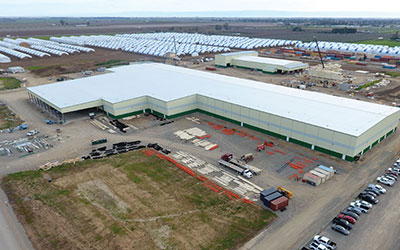Featured Division
Public Finance Division (PFD)
January 2020
At the core of what the State Treasurer’s Office does day in and day out are the activities of the Public Finance Division (PFD). Everything from the communities in which we live to the national financial markets are affected by what goes on in this important division of the State Treasurer’s Office.

Artist’s rendering of the planned expansion of the West Sacramento headquarters of CalSTRS, a project funded through green bonds sold through the Public Finance Division.
Treasurer Fiona Ma, supported by the PFD, acts as the agent for sale on all state bonds, including conduit bonds issued by state financing authorities. Through the PFD and the sale of bonds the state acquires funding for projects that benefit the public. California voters often mandate such bond issues.
Examples of the types of projects funded by California bonds regularly appear in the pages of this newsletter in a feature called, “The Vault” where you will find a reference to the December 5, 2019 sale of $272.6 million of lease revenue bonds that are providing funding to build an environmentally cutting-edge expansion of the Sacramento headquarters of the California State Teachers’ Retirement System. This past fall the PFD also sold bonds to fund construction projects for CalFire; jails in Riverside, Santa Barbara, Tulare and Sutter counties for the California Department of Corrections and Rehabilitation (CDCR); as well as the No Place Like Home program, which provides permanent supportive housing for persons who are experiencing or at risk of homelessness.
Bonds also may be sold by the state to build dams, airports, seaports, roads, railways, public water systems, schools, hospitals, and much more. California is the largest municipal issuer of debt in the nation and so has a very visible and important presence in the capital markets. As of November 1, 2019, California had approximately $80.7 billion of General Obligation (GO) Bonds and Lease Revenue Bonds (LRBs) outstanding.
The PFD is deeply interested in every aspect of the sale of California bonds, but the Division’s mission statement makes clear the narrow nature of its primary focus. The mission of the PFD is to effectively and efficiently manage the state’s debt programs and minimize the state’s borrowing costs.
Keeping the state’s borrowing costs as low as possible is serious business. It translates into a correspondingly lower public expense and the savings to taxpayers can be especially significant when costs are reduced through the PFD’s strategic refinancing of existing, older bonds to achieve more favorable borrowing terms.
Since becoming the State Treasurer one year ago, Fiona Ma has been the agent of sale for $6.17 billion of Refunding GO bonds and in the process has saved taxpayers $1.8 billion on a present value basis, or more than an anticipated $2.3 billion over the next 20 years.
Bonds handled by the PFD range from financial instruments known as General Obligation (GO) Bonds to Conduit Revenue Bonds. Here is a short primer on some bond types of importance to our state government:
- General Obligation (“GO”) Bonds: The State Constitution prohibits the creation of general obligation indebtedness of the state except when a bond measure wins the approval of a majority of the electorate voting in a general election, or a direct primary. A GO bond measure advances to the ballot on a two-thirds vote of all members to each house of the Legislature, or by a voter initiative if enough signatures are collected from the public. Each bond act provides a continuing appropriation from the state’s General Fund to cover debt repayment. A recent example is the September 5, 2019 sale of GO bonds through the PFD to provide funding for Prop 51 (the Kindergarten through Community College Public Education Facilities Bond Act of 2016).
- Lease Revenue Bonds (“LRBs”): In addition to GO bonds, the state acquires and constructs capital facilities through the issuance of LRBs. Such borrowing must be authorized by the Legislature in a separate act or appropriation. The State Public Works Board uses the proceeds of the bonds to pay for the acquisition or construction of facilities such as office buildings, courthouses or correctional institutions. These facilities are leased to the state and the lease provides the source of revenues that pay back the bonds. Recent examples include the CalFire and CDCR projects cited above.
- Revenue Anticipated Notes (RANs”): When necessary, the state issues RANs to partially fund timing differences between receipts and disbursements within a particular fiscal year. (The state has not issued RANs in recent years.)
- Revenue Bonds: These bonds pay for specific revenue producing enterprises and projects, and the revenues generated by that enterprise or project provide the source of repayment for the bonds. Issuers of state revenue bonds include, among others: Department of Water Resources; Department of Veterans Affairs; University of California; California State University (CSU), California Infrastructure and Economic Development Bank; California Housing Finance Agency; California Earthquake Authority. A recent example is the sale of CSU Systemwide Revenue Bonds to finance the acquisition, construction, renovation and improvement of various facilities on CSU campuses.
- Conduit Revenue Bonds: Although issued by a government entity, the proceeds are loaned to a nongovernmental borrower for purposes that are permitted in the Internal Revenue Service Code. The nongovernmental borrower repays the loan. A recent example is the CalPlant I, LLC, project issued through the California Pollution Control Financing Authority. Funds raised for this project will be used to complete construction of a plant that treats and disposes of solid waste left behind as California rice is harvested. The plant recycles waste rice straw (from the farming and harvesting) into medium density fiberboard.

When construction is complete, CalPlant I will be the world’s first commercial-scale producer of rice-straw-based medium density fiberboard.
An interactive online tool developed by the State Treasurer’s Office called DebtWatch is available on the Treasurer’s website and allows anyone to explore bonded debt at a local government level up through and including state indebtedness.
Much more information about the Treasurer’s Public Finance Division, state finances, credit ratings and upcoming bond offerings can be found at BuyCaliforniaBonds.com.
ScholarShare 529 Assists Non-profits and Local Governments
ScholarShare 529, California’s official college savings plan, has launched a platform designed to assist local governments and non-profits interested in launching their own Children’s Savings Account (CSA) program.
Local governments and non-profits may establish these accounts for young children, often with an initial seed contribution, to help them save for higher education. One key goal is to inspire children to perform well in school and realize that higher education is in their future.
ScholarShare 529 has partnered with VistaShare to utilize its platform Outcome Tracker to assist CSA program administrators. It is especially timely because the Legislature and the Governor have allocated $25 million in the current budget to fund the CSA Grant Program which will provide support to new and existing CSA programs.
Outcome Tracker offers CSA administrators a number of features including easy import of child data, application of additional contributions and incentives, direct interaction with parents, data reporting, and seamless interaction with ScholarShare 529 accounts.
ScholarShare 529, a gold-rated college savings plan, offers families a diverse set of high-quality, low-fee investment options. Any growth from the investments is tax-free as long as it is used to pay for qualified higher education expenses, including tuition and fees, books, certain room and board costs, computer equipment and other required supplies.
Note: Each month we will be sharing information on one of our BCAs and explain how the programs behind the acronym are enhancing the lives of Californians all across the state -- and how you, your family, or your business can share in, and contribute to, California's prosperity
January 2020 Articles
Newsletter Downloads
- January 2020
HTML version, PDF version - Year-End Highlights 2019
HTML version, PDF version - December 2019
HTML version, PDF version - November 2019
HTML version, PDF version - October 2019
HTML version, PDF version - September 2019
HTML version, PDF version - August 2019
HTML version, PDF version - July 2019
HTML version, PDF version - Half-Year Highlights: Jan - Jun 2019
HTML version, PDF version - May 2019
HTML version, PDF version - April 2019
HTML version, PDF version - March 2019
HTML version, PDF version - February 2019
HTML version, PDF version

